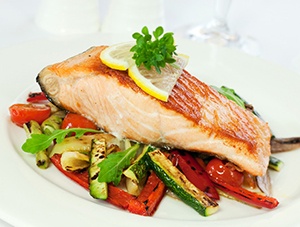By: Jacqueline Gomes, RDN, MBA
November 2nd, 2018
November is Diabetes Awareness Month; now is a great time to revisit healthy eating strategies for you or those you love managing the condition.
Diabetes is a condition many people struggle to control daily, however, taking small steps towards a healthier lifestyle is one way to reduce the stress of managing your blood sugar daily.
As a person with diabetes, you don’t necessarily need “special foods”. The American Diabetes Association® reminds us that, as with all foods, you need to work them into your individualized meal plan in appropriate portions.
12 Steps to your Diabetes Friendly Supermarket Roadmap!
- Nonstarchy Veggies: Eat at least 3-5 servings of vegetables daily – Spinach, collards, kale and tomatoes.
- Starchy Veggies: Keep portions small, these count towards your total carb intake – Try sweet potatoes!
- Fresh Fruit: Rich in vitamins and minerals. Fruits contain carbs so count them towards your meal plan. – Try citrus fruits and a variety of berries.
- Poultry & Meat: Choose white, skinless meat or lean cuts of meat that are lower in saturated fat.
- Fish & Seafood: Include fish twice a week – bake, poach, grill or broil.
- Eggs: A great protein choice, add variety to your meals by scrambling or boiling an egg!
- Regular & Greek Yogurt: Some nonfat or lowfat Greek yogurts have twice the protein of regular yogurts (12g & 5g protein respectively per 5.3oz serving). Look for light varieties with delicious flavors and 0% fat per serving.
- Milk: Choose one cup of fat-free or lowfat milk for 12grams of carbohydrate, 8 grams of protein and calcium.
- Dried Beans, Legumes, Peas, Lentils, Nuts & seeds: A source of protein and fiber, try to include weekly. Keep in mind that dried beans also count as a starch, so make them count towards your carbohydrate intake.
- Whole Grains: Check that whole grains like brown rice, buckwheat, oatmeal, quinoa, rolled oats, and whole-grain barley, corn, rye or wheat are first on the ingredient list. Try pearled barley and oats/oatmeal.
- Spreads & Oils: Choose vegetable oils or plant-based spread that have no partially hydrogenated vegetable oils (no trans-fat). Watch portion sizes since all fats are high in calories.
- Beverages: Choose zero-calorie or very low-calorie drinks. Try lemon and cucumber water for a refreshing way to stay hydrated!
Sources:
- American Diabetes Association®
- The Dannon Company®, Inc.
Greek Salmon and Veggie Packets
Prep: 20 Minutes
Makes: 4 Servings
Ingredients:
- Nonstick cooking spray
- ¼ cup lemon juice
- 2 cloves garlic, minced
- 1 tablespoon minced fresh oregano
- 1 teaspoon salt (optional)
- 1 tsp black pepper
- 1 thinly sliced medium zucchini
- 1 medium red bell pepper (seeded and sliced into thin strips)
- 4 (4-ounce each, skinless) salmon fillets
- 2 teaspoons olive oil
Directions:
- Preheat oven to 400°F. Spray 4, 8×8-inch sheets of aluminum foil with cooking spray. Set aside.
- Combine lemon juice, garlic, oregano, salt (optional) and pepper in a small bowl. Set aside.
- Place 1/4 of zucchini, onion and bell pepper on each sheet of foil. Top each one with a salmon fillet.
- Pour 1/4 of lemon juice mixture over each salmon fillet. Top with 1/2 Tsp. olive oil.
- Bring foil sides up on both sides and seal. Place on baking sheet and bake in oven for 20 minutes.
- Safety Tip: Be careful when opening the foil packets because the steam can burn you.
Nutrition Information per packet: 260 Calories, 9g Carbohydrate, 2g Fiber, 27g Protein, 13g total fat (2g Saturated)
Recipe: American Diabetes Association®

